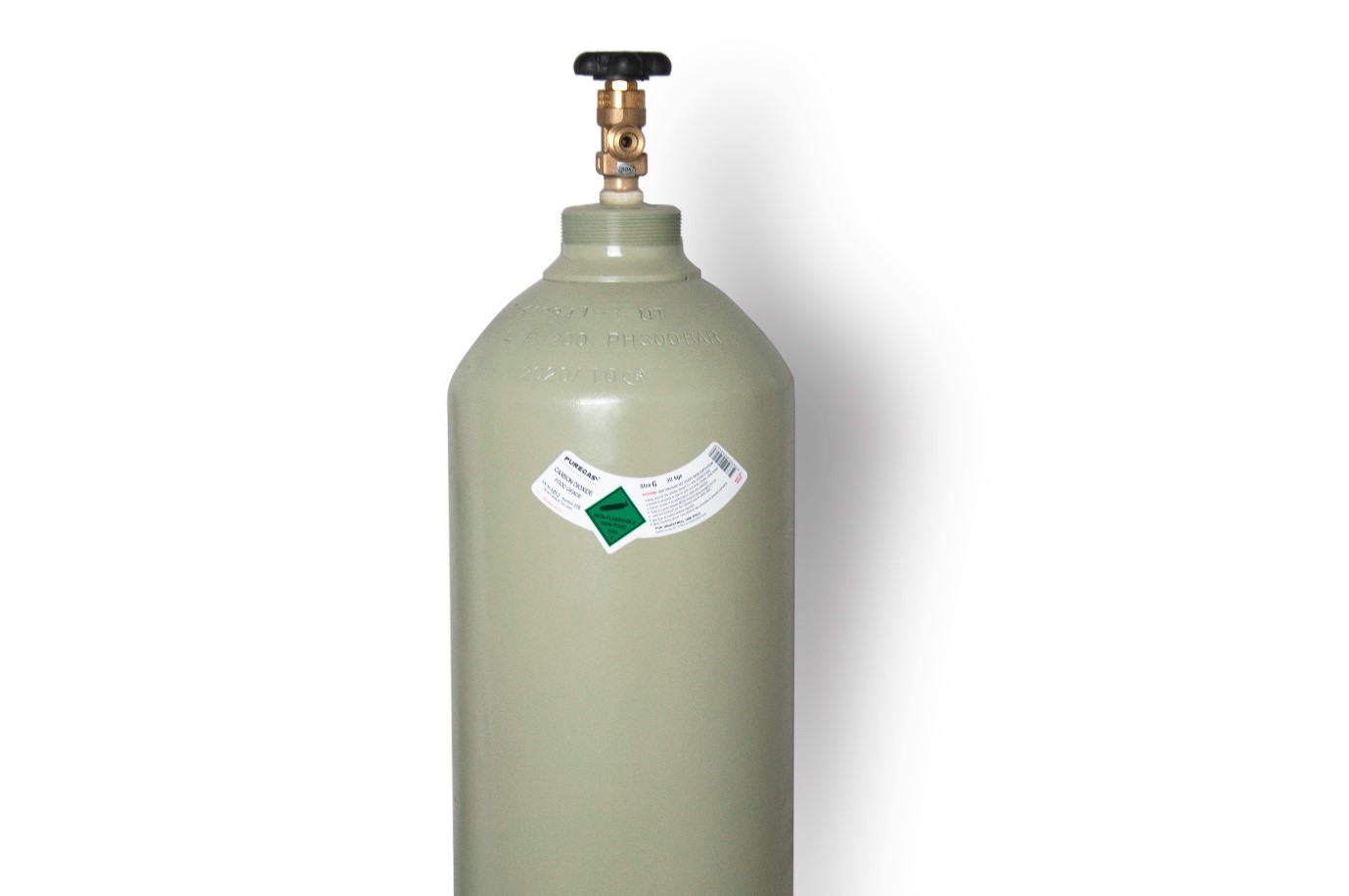

Carbon Dioxide whilst acting as an asphyxiant must not be inhaled.
It is largely inert and is neither flammable nor supports combustion & is used in some fire extinguishers.
At a density 1.87 kg/m3 (1.55 relative to air at normal atmospheric conditions) it is markedly denser than air so it is potentially dangerous if inadvertently released in a cellar.
Applications
- Carbonation of beverages
- Acidity regulator in food products
- Preservation of wine and fruit juices
- Various chemical processes
- Fire extinguishers
- As a refrigerant for low temperatures
- Increased productivity in Greenhouses
- Recharging of natural mineral waters with carbon dioxide
- Tapping of beer and prevention of oxidation through contact with the air
- Accelerating the growth of farm produce as an atmosphere additive
- Production of paints and varnishes
- Manufacture of foam rubber
Product Overview
Carbon Dioxide whilst acting as an asphyxiant must not be inhaled.
It is largely inert and is neither flammable nor supports combustion & is used in some fire extinguishers.
At a density 1.87 kg/m3 (1.55 relative to air at normal atmospheric conditions) it is markedly denser than air so it is potentially dangerous if inadvertently released in a cellar.
Applications
- Carbonation of beverages
- Acidity regulator in food products
- Preservation of wine and fruit juices
- Various chemical processes
- Fire extinguishers
- As a refrigerant for low temperatures
- Increased productivity in Greenhouses
- Recharging of natural mineral waters with carbon dioxide
- Tapping of beer and prevention of oxidation through contact with the air
- Accelerating the growth of farm produce as an atmosphere additive
- Production of paints and varnishes
- Manufacture of foam rubber
Hazards
Carbon Dioxide acts largely as an asphyxiant and must not be inhaled. At very high concentrations, leads to less of consciousness and eventually death.
Carbon dioxide is largely inert & non-toxic & non-flammable, so from the point of fires is relatively safe.
Cylinder Sizes
|
Specifications |
C |
D |
E |
F |
G |
|
Contents weight (kg’s) |
2.6 |
6 |
15 |
22 |
30 |
|
Cylinder water capacity (L) |
4 |
10 |
25 |
40 |
50 |
|
Cylinder colour |
Green grey |
||||
|
Cylinder connection type |
Type 30 |
||||
Slight variations in the dimensions & weight of the cylinder can be expected due to manufacturing tolerances.
The weight of the CO2 gas filled will be as specified above.
Important Info
Cylinder handling and storage
- Make sure the cylinder is equipped with the correct regulator and end connectors with appropriate pressure ratings.
- Inspect the regulator and cylinder valves for grease, oil, dirt, and solvent. Never use grease or oil to lubricate regulators or cylinder valves as this will contaminate the gas.
- Open (Anti clockwise looking down at the hand wheel, directional arrows are on the hand wheel.) or close a cylinder valve (Clockwise looking down at the hand wheel, directional arrows are on the hand wheel.) by hand (Too much closing torque can damage the cylinder valve seat.) using moderate torque to open or close them. Only use set spanners or specific tools that are provided by the cylinder supplier to connect accessories. Multi-grips should never be used. Some regulators require a sealing washer in or on the inlet spigot. Check that this is present before fitting the regulator to the cylinder valve outlet
- Gas cylinders (particularly G & E size) are unstable & must be stored in pallets or racks when not in use & secured when in use by a strap or chain against a wall or secured by a suitable trolley with chain or strap.
- Use appropriate materials for chains. E.g. plastic coated wire cable, commercial straps, with tensioners,… etc., to secure cylinders.
- Gas cylinders should not be stored in public hallways or other unprotected areas
- Store out of direct sunlight and away from sources of heat and ignition; temperatures must not exceed 50 °C.
- Where cylinder caps are fitted to cylinders (i.e. instead of Cylinder Valve guards.) refit these cylinder valve caps to the Cylinder thread when the cylinder is not in use.
- Cylinders should be protected from damage. Do not store cylinders near elevators or gangways, or in locations where heavy-moving objects may strike or fall on them or knock the cylinder over.
- Cylinders must be stored on surfaces such as suitably drained concrete to prevent the base of the cylinder from rusting from standing in puddles for long periods. Cylinders should be stored, secured in premises to protect them from theft & against tampering by unauthorized individuals.
- Storage areas must be well-ventilated, cool, dry, and free from corrosive materials.
Handling leaks
- If closing the Cylinder Valve does not stop the leak, then relocate the cylinder to a safer well ventilated or outdoor location to allow the venting gas to escape & not build up.
i.e. Per Puregas Safety Guidelines.
- Do not enter an area with high gas leakages without proper PPE or safety equipment.
- Approach the leak only if qualified to do so.
- Use readily available techniques like the soap bubble method to detect the leak.
- Return the empty cylinder if the leak persists or after the gas has been safely vented.
- Make sure the cylinder is properly tagged indicating the nature, location & date of the leak together with a contact name & phone number for follow up by the gas supplier.




 Facebook
Facebook Instagram
Instagram